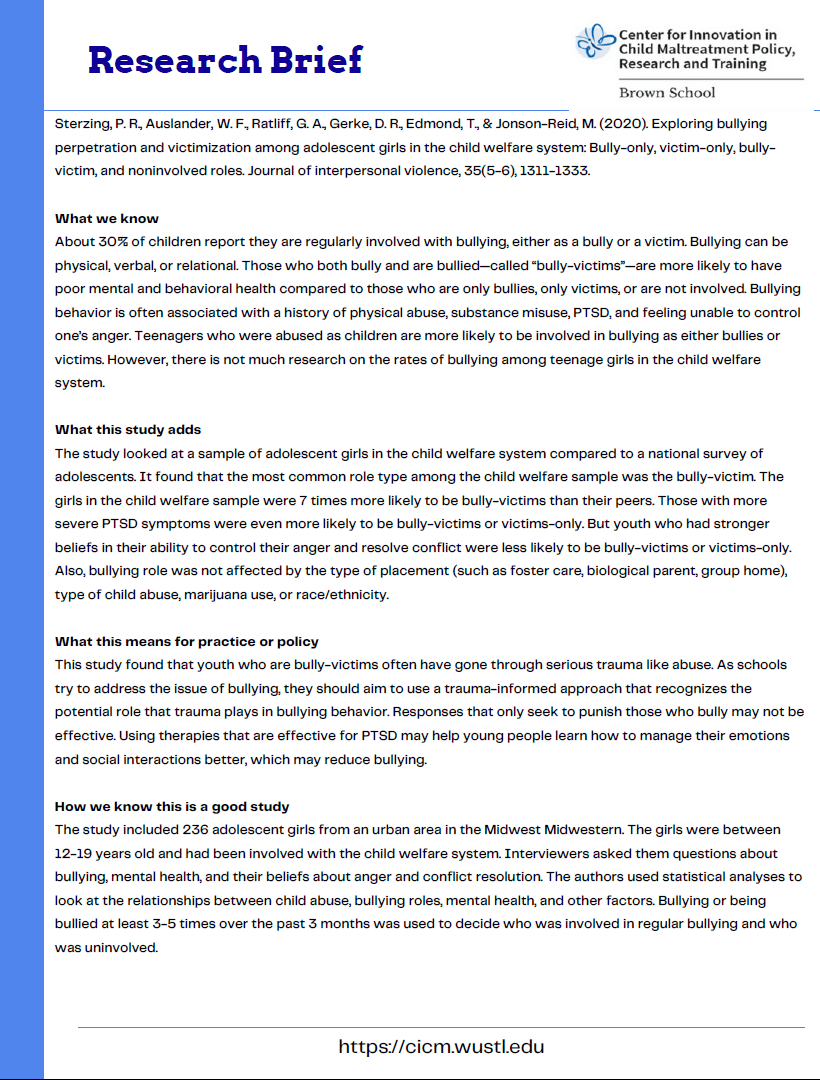Exploring Bullying Perpetration and Victimization Among Adolescent Girls in the Child Welfare System
Research Brief

Sterzing, P. R., Auslander, W. F., Ratliff, G. A., Gerke, D. R., Edmond, T., & Jonson-Reid, M. (2020). Exploring bullying perpetration and victimization among adolescent girls in the child welfare system: Bully-only, victim-only, bully-victim, and noninvolved roles. Journal of interpersonal violence, 35(5-6), 1311-1333.
What we know
About 30% of children report they are regularly involved with bullying, either as a bully or a victim. Bullying can be physical, verbal, or relational. Those who both bully and are bullied—called “bully-victims”—are more likely to have poor mental and behavioral health compared to those who are only bullies, only victims, or are not involved. Bullying behavior is often associated with a history of physical abuse, substance misuse, PTSD, and feeling unable to control one’s anger. Teenagers who were abused as children are more likely to be involved in bullying as either bullies or victims. However, there is not much research on the rates of bullying among teenage girls in the child welfare system.
What this study adds
The study looked at a sample of adolescent girls in the child welfare system compared to a national survey of adolescents. It found that the most common role type among the child welfare sample was the bully-victim. The girls in the child welfare sample were 7 times more likely to be bully-victims than their peers. Those with more severe PTSD symptoms were even more likely to be bully-victims or victims-only. But youth who had stronger beliefs in their ability to control their anger and resolve conflict were less likely to be bully-victims or victims-only. Also, bullying role was not affected by the type of placement (such as foster care, biological parent, group home), type of child abuse, marijuana use, or race/ethnicity.
What this means for practice or policy
This study found that youth who are bully-victims often have gone through serious trauma like abuse. As schools try to address the issue of bullying, they should aim to use a trauma-informed approach that recognizes the potential role that trauma plays in bullying behavior. Responses that only seek to punish those who bully may not be effective. Using therapies that are effective for PTSD may help young people learn how to manage their emotions and social interactions better, which may reduce bullying.
How we know this is a good study
The study included 236 adolescent girls from an urban area in the Midwest. The girls were between 12-19 years old and had been involved with the child welfare system. Interviewers asked them questions about bullying, mental health, and their beliefs about anger and conflict resolution. The authors used statistical analyses to look at the relationships between child abuse, bullying roles, mental health, and other factors. Bullying or being bullied at least 3-5 times over the past 3 months was used to decide who was involved in regular bullying and who was uninvolved.